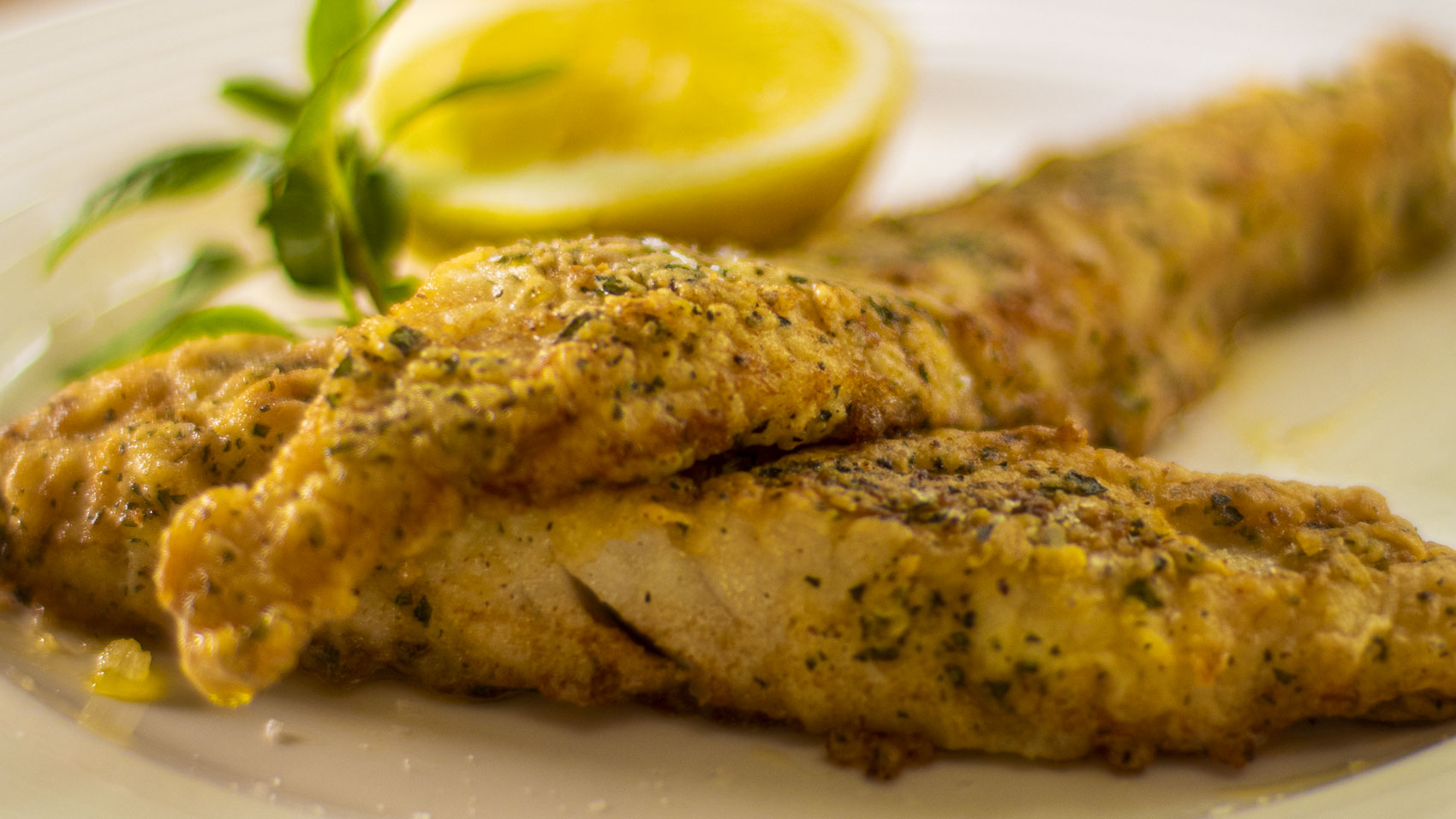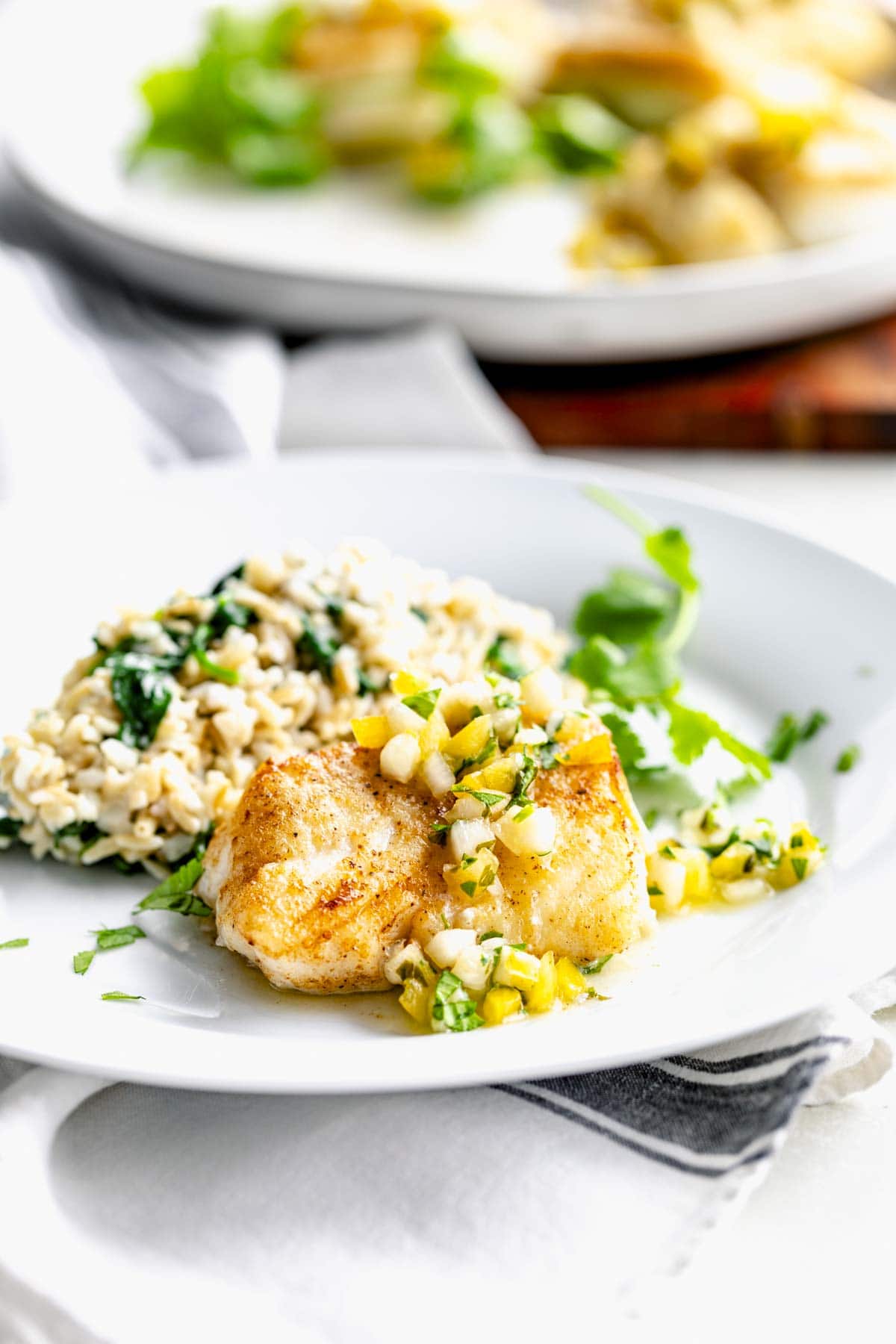Find out how to pan-fry fish in less than 20 minutes! To make sautéed fish that always turns out right, coat your fish filet in seasoned flour and cook it in a hot skillet with butter and oil. The fish will be soft and flaky, and the outside will be a delicious golden brown color. This method is easy to learn and a great way to make fish a regular part of your diet.
Disclosure: This post contains affiliate links. We originally shared this recipe on February 21st, 2020. I have updated some of the text to share it with you again today.
Butter-fried fish is a quick easy and delicious way to prepare fish that highlights its natural flavor. But is butter really the best oil for frying fish? And what’s the healthiest way to cook fish in butter?
In this article, we’ll discuss the advantages and proper techniques for frying fish in butter. Read on for answers to common questions about cooking fish in butter along with tips for maximizing nutrition.
What is Butter-Fried Fish?
Butter-fried fish refers to fish fillets or pieces that are dipped in flour egg and breadcrumbs then pan-fried in hot butter until golden brown and crispy. Clarified butter is often used as it can withstand higher heat without burning. The butter imparts a characteristically rich, nutty flavor.
Common choices like tilapia, cod, haddock, sole and snapper all shine when butter-fried. The fish emerges tender on the inside with a delicate, flaky texture encased in a savory golden crust.
What Are the Benefits of Frying Fish in Butter?
Butter has distinct properties that make it an excellent choice for frying fish:
-
Butter contains milk solids that brown and lend rich flavor to fried foods. Oil cannot replicate this taste.
-
The milk fat in butter helps fried foods brown faster without overcooking the interior.
-
Butter has a high smoke point when clarified, so it can get hot enough to fry foods.
-
Fish fried in butter absorbs less oil than it would in vegetable oil, resulting in a less greasy product.
-
The pleasing mouthfeel of butter balances the lean texture of fish. Oil-fried fish can taste flat and oily in comparison.
So when cooking methods like pan frying, sautéing or deep frying are called for, butter is ideal for maximizing the flavor and texture of fish.
Tips for Cooking Fish in Butter
Follow these tips to successfully pan-fry fish fillets in butter:
-
Choose a sturdy fish that won’t fall apart easily like tilapia, sole, trout, bass or catfish.
-
Cut fish into same-size portions for even cooking. Pat dry before flouring.
-
Clarify the butter by simmering and skimming milk solids to allow higher frying heat.
-
Use a cast iron or nonstick skillet over medium-high heat to prevent butter from burning.
-
Pat flour mixture onto fish fillets to help it adhere versus dipping to prevent a gummy batter.
-
Fry fish just 2-3 minutes per side until golden brown. Avoid overcooking or it will be dry.
-
Monitor heat closely and adjust to prevent butter from burning. Burnt butter ruins the flavor.
With these tips, you can achieve deliciously golden brown, tender fish with butter’s signature flavor.
What Are Some Healthy Ways to Fry Fish in Butter?
While butter adds great flavor, some opt for oil when frying fish for a healthier profile. Here are some modifications for lightening up butter-fried fish recipes:
-
Use clarified butter with milk solids removed to eliminate some saturated fat.
-
Combine butter with olive oil or avocado oil for a portion of healthy unsaturated fats.
-
Substitute almond flour for some of the wheat flour in the coating to reduce carbs.
-
Choose wild-caught fish like salmon and trout to maximize omega-3 content.
-
Bake or broil the floured fish on a wire rack after browning in butter to reduce overall butter intake.
-
Add lemon juice and fresh herbs to complement the butter without needing as much.
So with smart tweaks, fried fish in butter can be lightened up while still retaining that irresistible buttery flavor.
Sample Recipe – Easy Butter-Fried Tilapia
This simple recipe for pan-fried tilapia showcases butter’s talent for producing crispy, flavorful fish:
Ingredients:
-
4 tilapia fillets (6 oz each)
-
1⁄2 cup flour
-
1 tsp paprika
-
1⁄2 tsp salt
-
1⁄4 tsp pepper
-
2 tbsp olive oil
-
3 tbsp butter
-
Lemon wedges
-
Chopped parsley
Instructions:
-
Combine flour, paprika, salt and pepper. Dredge tilapia fillets in flour mixture to coat both sides.
-
Heat olive oil and butter in large skillet over medium-high heat.
-
When butter is foamy, add floured tilapia fillets and fry for 2-3 minutes per side until golden brown.
-
Transfer fish to paper towel-lined plate. Serve garnished with lemon and parsley.
The ease of pan frying makes this dish convenient any night of the week. The tilapia gets a tasty crust from the flour and butter combo.
The Takeaway on Frying Fish in Butter
While not the leanest cooking method, frying fish in butter adds incredible depth of flavor. Clarifying the butter raises its smoke point so fish achieves a beautifully crisp exterior. For the healthiest approach, use olive oil along with the butter and opt for low-mercury, sustainable fish. With a few tweaks, buttery fish can be enjoyed as part of balanced diet. Just practice moderation, as with any fried food. So embrace butter and its seductive taste – your fish will thank you.

Step 4: Flip and Finish Cooking
With a fish spatula, carefully flip the fillet over and keep cooking for another 30 seconds to 3 minutes, or until it’s fully cooked. Check for doneness by cutting into a fillet to make sure it is cooked to your liking. Don’t wait for the fish to flake, as that is a sign it is overcooked.
TIP: A narrow and thin fish spatula is very helpful to flip the fish. These fillets are delicate and can break apart easily when flipped.
Transfer the fillets to plate and lightly tent with foil to keep warm.

Ingredient Notes For Sauteed Fish
- Fillets of fish without bones: This method works best for fillets of mild-tasting white fish like tilapia, flounder, sole, cod, or haddock that are no more than 1 inch thick. This was great with both cod and tilapia. Aim for the portions to be about 5 ounces each.
- To season the fish, you’ll need salt and freshly ground black pepper.
- Flour: Molly says to use rice flour for this method, but you can use all-purpose flour instead if you don’t have any. We like the rice flour version a little better because it doesn’t get as clumpy, but either way is tasty, so don’t let the fact that you don’t have rice flour stop you. If you use all-purpose flour, make sure to shake off the extra so the dough doesn’t get sticky.
- Salt-free butter: Molly’s recipe calls for all butter, but we added 1 tablespoon of avocado oil or organic canola oil to make it more in line with the Healthy Seasonal Recipes rules. It does work just as well to use all butter. It really helps to make the crust browner and bring out the flavor.
- Sauce: We liked this best with store-bought pineapple salsa, but Molly’s caper sauce was also great. Check out our other sauce suggestions below.
Pan fried fish – With Butter
How do you cook fish with butter?
Throughout the process, the butter browns and coats the mild fish in savory flavor, adding richness. We add thyme sprigs and crushed garlic cloves to the pan, which infuse the butter as it heats and makes for an aromatic dish. Lemon wedges are a must; the brightness of the lemon juice cuts through the butter’s richness. –America’s Test Kitchen
Is deep frying butter safe?
Deep frying butter is safe, but as other sorts of fat, it’s recommended not consume it every day. What is more, when people are warming butter, the level of oxidation is always increasing and the result is that this kind of food become unhealthy.
What is fish fried in butter?
Fish fried in butter is an elegant dish that is simple to prepare. A basic recipe for sole meuniere, which comes from the Normandy region of France, can be used for pan-frying any type of fish fillet in butter. You can also use it to cook flatfish such as flounder or halibut.
Can you fry fish in buttermilk?
“A little buttermilk bath does wonders for fresh fish fillets such as catfish, flounder, trout or grouper,” she writes. “Just half an hour in the buttermilk will sweeten the fish and keep it deliciously moist. In the old days, we’d fry the fish in Crisco, but now it’s usually vegetable oil, with maybe a little bacon grease or butter for flavor.”
